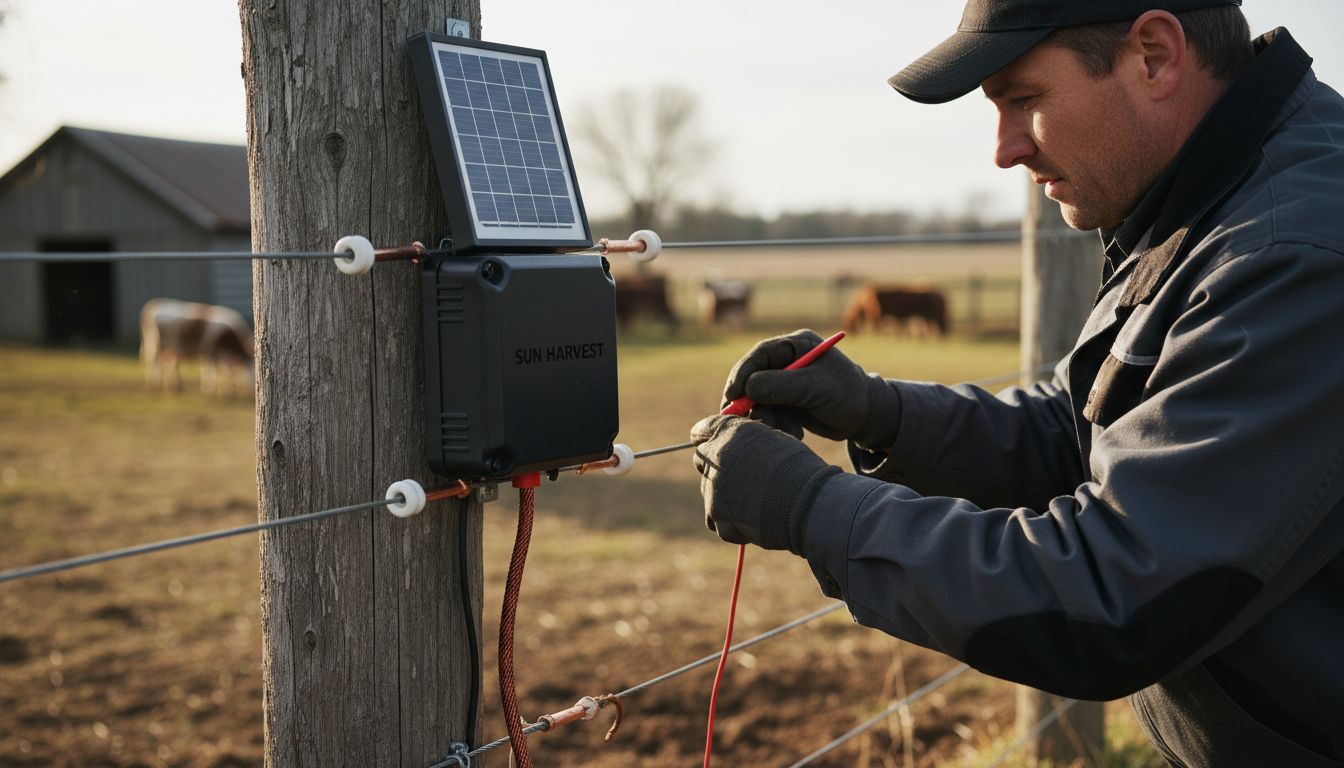Nearly 60 percent of farmers now turn to solar energy for field security, relying on technology that works anywhere, even far from power lines. Traditional fences often fail in remote locations, but solar fence systems bring reliable protection while cutting electricity costs and carbon emissions. Discover how this innovative solution powers electric fencing with nothing but sunlight, offering added safety for your property and peace of mind for every livestock owner.
Table of Contents
- What Is A Solar Fence System
- How Solar Fence Systems Function
- Types Of Solar Electric Fencers
- Benefits And Practical Advantages
- Installation And Maintenance Requirements
- Common Pitfalls And Safety Considerations
Key Takeaways
| Point | Details |
|---|---|
| Solar Fence System Overview | A solar fence system uses solar energy to power electric fencing, making it suitable for remote locations without traditional electricity. |
| Functionality | The system converts sunlight into electrical energy stored in batteries, enabling a continuous high-voltage electric barrier along fence wires. |
| Benefits | Advantages include eco-friendly operation, low maintenance, and humane deterrence for livestock management and property security. |
| Installation & Maintenance | Effective installation requires optimal solar panel placement, while regular maintenance ensures reliable performance and safety. |
What Is A Solar Fence System
A solar fence system is an innovative agricultural and property security solution that leverages solar energy to power electric fencing. According to raubikaner, this technology utilizes solar panels to generate electricity, which is then stored in batteries to provide a continuous, high-voltage electrical barrier.
The core mechanism of a solar fence system is straightforward yet ingenious. As explained by scitepress, photovoltaic panels convert sunlight into electrical energy, which is stored in batteries. This stored energy ensures the fence operates consistently, even during periods without direct sunlight. The energizer then transforms this stored power into high-voltage electrical pulses that travel along the fence wires.
Key components of a solar fence system typically include:
- Solar panel(s) for energy generation
- Rechargeable battery storage unit
- Electric fence energizer
- Conductive fence wires
- Grounding system
These systems offer multiple advantages for farmers, ranchers, and property owners. They provide a non-lethal deterrent for livestock management and perimeter security, functioning effectively in remote locations without traditional electricity access. The environmentally friendly design means reduced operational costs and minimal carbon footprint compared to conventional electric fencing powered by grid electricity.
For those managing livestock or protecting agricultural properties, solar fence charger guide can provide additional insights into selecting and implementing the right solar fence system for specific needs.
How Solar Fence Systems Function
Solar fence systems operate through a sophisticated yet straightforward energy conversion process. According to raubikaner, the system begins with solar panels capturing sunlight and converting it into electrical energy, which is then stored in specialized batteries. This stored energy becomes the critical power source for the entire electric fencing mechanism.
The core functionality involves an energizer that transforms the low-voltage battery current into high-voltage electrical pulses. As scitepress explains, these pulses travel along the fence wires, creating an electrical barrier that delivers a brief, non-lethal shock when touched. This shock serves as a powerful psychological deterrent for animals or potential intruders without causing lasting harm.

Key operational steps include:
- Solar panels capture sunlight
- Electrical energy is converted and stored in batteries
- Energizer transforms stored energy into high-voltage pulses
- Pulses distribute through conductive fence wires
- Touching the wire triggers a momentary electrical shock
To ensure optimal performance, solar fence systems require strategic placement of components. The solar panel needs direct sunlight exposure, while the battery and energizer should be protected from extreme weather conditions. For farmers and ranchers looking to implement this technology effectively, our guide to portable solar electric fences offers comprehensive insights into selecting and maintaining these innovative security solutions.
Types Of Solar Electric Fencers
Solar electric fencers come in various configurations designed to meet different agricultural and property management needs. According to pubs, portable solar energizers are particularly popular, offering flexibility for temporary fencing applications. These devices typically provide less than 1 output joule, with some larger models reaching up to 2 output joules.
The classification of solar electric fencers primarily depends on their intended use and design characteristics. Scitepress highlights two main categories: temporary and permanent solar electric fence systems. Temporary systems are lightweight, easily movable, and ideal for short-term fencing needs, while permanent installations feature more robust solar panels and battery systems for continuous, long-term security.

Key types of solar electric fencers include:
- Portable Solar Energizers: Lightweight, mobile units perfect for temporary fencing
- Permanent Solar Fence Chargers: Fixed systems with larger solar panels and battery storage
- Low-Output Energizers: Suitable for small pastures or garden protection
- High-Output Energizers: Designed for large livestock areas and extensive property boundaries
- Hybrid Solar Energizers: Can switch between solar and traditional power sources
For ranchers and farmers looking to select the most appropriate solar electric fencer for their specific needs, our portable solar fence energizer guide provides comprehensive insights into choosing the right system for various agricultural applications.
Benefits And Practical Advantages
Solar electric fences offer remarkable advantages for agricultural and property management applications. According to scitepress, these systems provide grid independence, making them exceptionally suitable for remote locations where traditional electrical infrastructure is unavailable or impractical. This autonomy translates to significant operational cost reductions by leveraging renewable solar energy.
Humane deterrence is another critical benefit highlighted by raubikaner. The solar electric fence creates a psychological barrier that prevents animal or human intrusion without causing lasting harm. The system delivers a sharp, brief shock that effectively communicates boundaries without inflicting permanent damage.
Key practical advantages include:
- Continuous Protection: Battery remains consistently charged
- Eco-Friendly Operation: Utilizes 100% renewable energy
- Low Maintenance: Minimal moving parts reduce repair needs
- Versatile Deployment: Suitable for various terrains and property types
- Cost-Effective: Eliminates ongoing electrical connection expenses
For farmers and ranchers seeking to implement an efficient perimeter protection solution, our best solar electric fence charger guide provides comprehensive insights into selecting and optimizing these innovative security systems.
Installation And Maintenance Requirements
Proper installation of solar electric fence systems requires careful planning and precise execution. According to pubs, solar energizers can be mounted on a 2-inch diameter post or placed on an elevated surface. The critical connection process involves attaching the ground wire to the black terminal and the fence wire to the red terminal, ensuring a secure and functional electrical circuit.
Raubikaner emphasizes the importance of strategic panel placement to maximize sunlight exposure. The solar panel’s positioning directly impacts the system’s efficiency, with optimal performance requiring unobstructed access to direct sunlight throughout the day. This careful positioning ensures consistent battery charging and reliable fence operation.
Key installation and maintenance steps include:
- Select an optimal location with maximum sun exposure
- Mount solar panel securely on a stable 2-inch post
- Connect ground and fence wires to correct terminals
- Clear vegetation around fence to prevent electrical shorts
- Conduct monthly battery and connection inspections
Critical maintenance practices involve:
- Regular solar panel cleaning
- Checking battery charge levels
- Inspecting wire connections
- Removing vegetation near fence lines
- Verifying energizer functionality
For ranchers seeking detailed guidance on implementing these systems, our install fence energizer solar system guide provides comprehensive step-by-step instructions for successful solar electric fence deployment.
Common Pitfalls And Safety Considerations
Solar electric fence systems require careful consideration to ensure optimal performance and safety. According to pubs, one critical aspect is matching the energizer’s output precisely to the fence’s length and type. Mismatched systems can lead to ineffective barriers and potential security vulnerabilities.
The electrical characteristics of these systems are designed with safety in mind. Raubikaner explains that the electric shock is engineered to be non-lethal, with current pulsating every 1 to 1.2 seconds for just a millisecond. This brief pulse allows animals sufficient time to move away, creating a psychological deterrent without causing lasting harm.
Common pitfalls to avoid include:
- Inadequate battery maintenance
- Poor solar panel positioning
- Insufficient ground wire connections
- Vegetation causing electrical shorts
- Incorrect energizer selection for fence length
Key safety considerations involve:
- Keep battery charge above 50%
- Regularly inspect fence for debris
- Ensure proper grounding
- Check wire connections monthly
- Clear vegetation near fence lines
For farmers seeking comprehensive guidance on navigating these challenges, our install fence energizer solar system guide offers detailed insights into safe and effective solar electric fence deployment.
Power Your Property with Reliable Solar Fence Solutions from FenceFast
Managing livestock or securing rural land using solar fence systems can sometimes feel overwhelming when it comes to selecting the right components and ensuring proper installation. This article highlights key challenges like maximizing solar panel placement, maintaining battery health, and choosing the correct energizer for your fence length. These factors are critical for achieving an effective and safe electric fence that protects your animals and property without fail.
At FenceFast, we understand these concerns and offer a wide range of electric fencing supplies designed specifically for agricultural and rural customers across Canada. From solar panels and energizers to connectors and fencing wire, you can find everything you need to build or upgrade your solar-powered fence system. With expert advice and nationwide shipping, we help you create a durable, low-maintenance, and eco-friendly barrier that keeps your livestock safe and secure.

Explore our electric fencing solutions now on FenceFast.ca. Take charge of your property’s security and livestock management today with trusted solar fencing products and guidance. Don’t wait until a weak fence causes costly problems. Visit us to find the perfect setup tailored to your rural needs.
Frequently Asked Questions
What is a solar fence system?
A solar fence system is a security and agricultural solution that uses solar energy to power electric fencing, providing a non-lethal barrier for livestock management and perimeter security.
How do solar fence systems work?
Solar fence systems operate by using solar panels to convert sunlight into electrical energy, which charges batteries. This stored energy powers an energizer that sends high-voltage pulses through the fence wires, creating an electrical barrier.
What are the different types of solar electric fencers available?
There are several types of solar electric fencers, including portable solar energizers for temporary fencing, permanent solar fence chargers for long-term use, and low-output or high-output energizers based on the specific needs of the property or livestock area.
What are the main benefits of using a solar electric fence?
The main benefits of solar electric fences include grid independence for remote locations, humane deterrence with non-lethal shocks, eco-friendly operation utilizing renewable energy, low maintenance requirements, and cost-effectiveness by eliminating ongoing electrical connection expenses.
